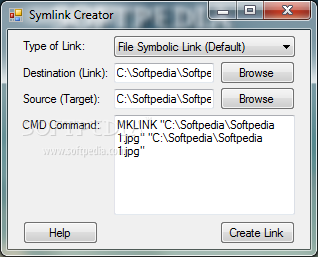

One thing to remember before using hard links is that you can’t create a hard link across different disk drives.

So, if you make any changes to a hard link, the changes will reflect in the original file. Consequently, the hard links that you create point to the same storage location on your hard drive. If I hard link sample.txt to a file named "test.txt," the OS will treat test.txt as though it was sample.txt.Įssentially, all hard links appear as the original file or directory. If you hard-link a file or a folder in location A to a file or a folder in location B, the file or folder at location B would appear as though it exists at location A.įor example, let’s assume that we have a text file called "sample.txt" in the C:\Programs directory. One of the advantages of a symlink is that it can cross filesystems. Unlike Linux, only soft links are called symlinks in Windows. Symlinks, short for symbolic links, are basically shortcuts to individual files or folders. Examples of outputting the last ten lines of a file, limiting the number of lines, limiting the number of bytes, showing multiple files, watching a file for changes and using pipes.There are two main types of symbolic links on Windows: Hard Links and Soft Links. Tutorial on using tail, a UNIX and Linux command for outputting the last part of files. Linux and Unix tail command tutorial with examples Examples of listing a directory, showing hidden files, showing long listings, sorting on various items and showing recursive listings. Tutorial on using ls, a UNIX and Linux command for listing directory contents.

Linux and Unix ls command tutorial with examples Examples of removing a file, removing multiple files, prompting for confirmation, removing recursively and forcing removal. It also shows up as an entry in a file listing in a terminal window. A symlink looks just like a regular file or directory in a file manager window. Tutorial on using rm, a UNIX and Linux command for removing files or directories. Symbolic links, also called soft links and symlinks, are a form of shortcuts that can point to files and directories. Linux and Unix rm command tutorial with examples You can edit it here and send me a pull request. The same data on disk as the target file. This has the effect of creating a new file that links to
#SYM LINK FULL#
To create a hard link using the ln command pass the full path of the targetįile and the link name. Symbolic links can linkĪcross file systems to link a folder on an external hard drive. Systems folders may only be linked using a symlink. The data on disk but to another link to the data on disk. Link allows multiple filenames to be associated with the same data on disk.Ī symbolic link (also sometimes known as a soft link) does not link directly to Both the originalįile and the hard link are direct links to the data on disk. This means data can beĪccessed directly via an original filename or a hard link. When a file is removed the data on disk remains but the file system hasĪ hard link is a direct link to the data on disk. Is created the filename connects a file system with bytes that have been written To understand the difference between a hard and symbolic link it is important toįirst understand the relationship between a file and data on disk. What is the difference between a hard and symbolic link? ¶ Supports creating a hard and symbolic links to data on disk. The ln command is a command line utility for making links between files. Examples of creating a hard link, creating a symbolic link, and a broken symbolic link. Tutorial on using ln, a UNIX and Linux command to make links between files. Linux and Unix ln command tutorial with examples


 0 kommentar(er)
0 kommentar(er)
